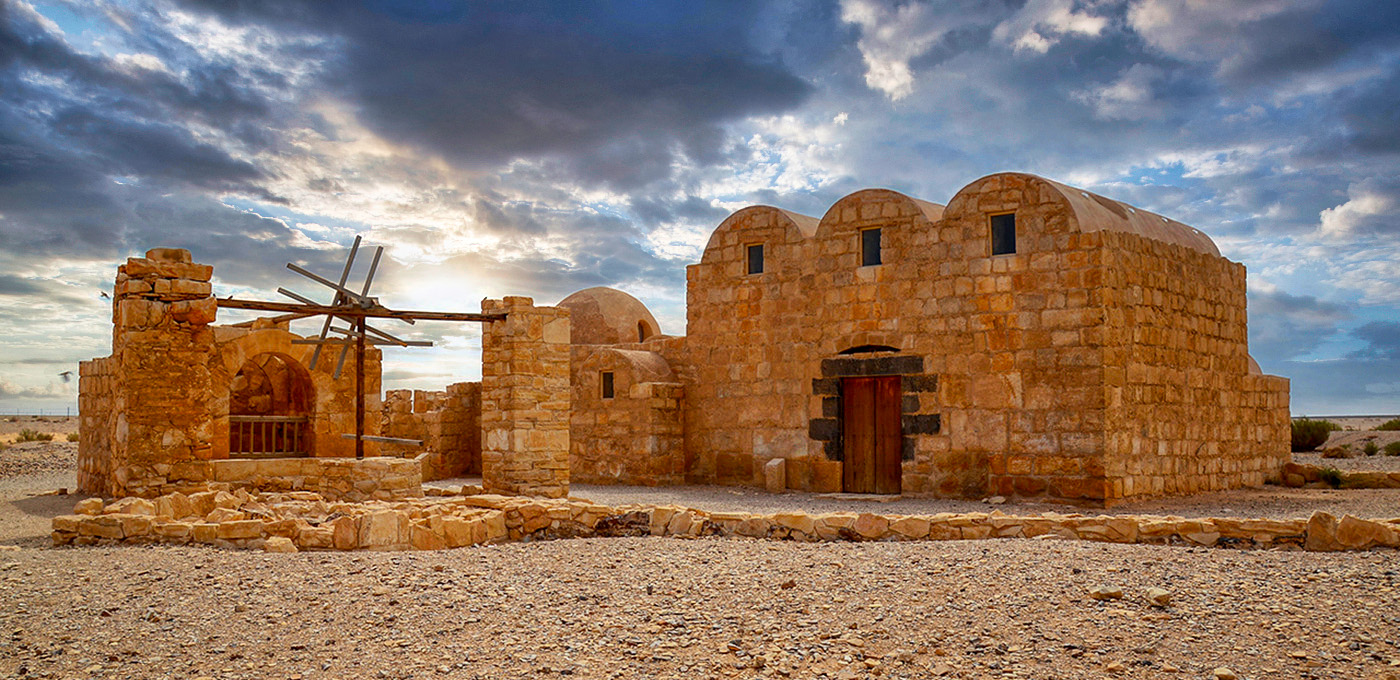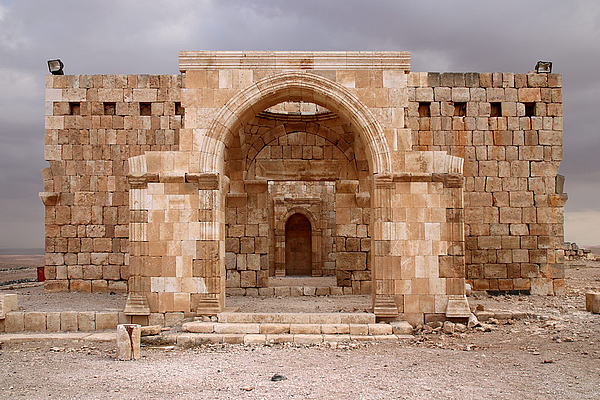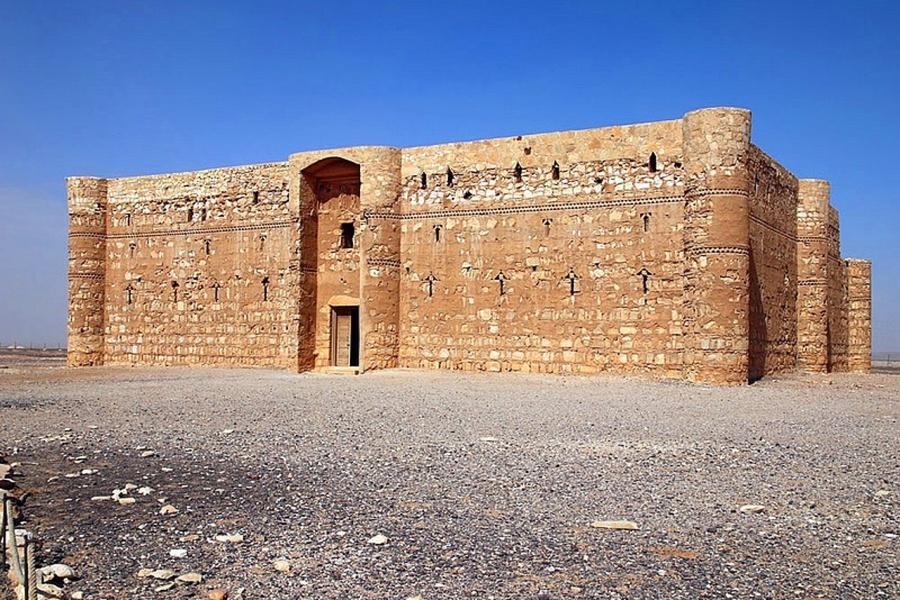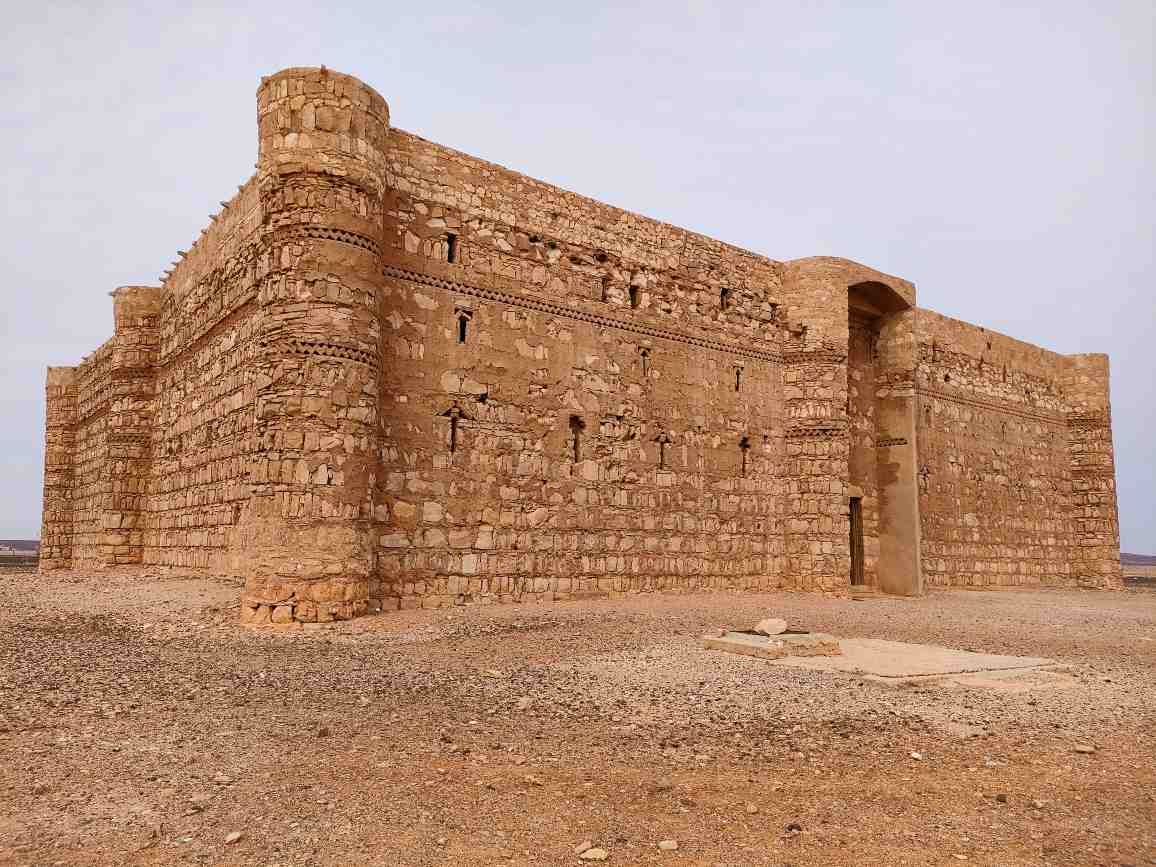A Guide to the Desert Castles of Jordan: History, Architecture, and How to Visit
Jordan's desert castles are more than just remnants of the past. These beautiful structures testify to a fascinating era in the country's rich history. Built during the Umayyad caliphate, these castles were not just fortresses but also hunting lodges, palaces, and caravanserais. Each castle has its unique story, offering a glimpse into the days of the Arab Revolt and the Crusades.
In this guide, we will dive into the history, architecture, and how to visit these remarkable desert castles in Jordan.

History of the Desert Castles of Jordan
The Desert Castles of Jordan are a collection of historically significant structures that showcase the region's rich cultural heritage. These castles were built during the Umayyad period (661-750 AD) and served various purposes, including hunting lodges, caravanserais, and agricultural complexes.
The construction of these castles was driven by the Umayyad rulers' interest in establishing their presence in the desert, controlling trade routes, and showcasing their power and wealth. The architecture of the castles reflects a blend of influences from Byzantine, Persian, and local Nabatean styles.
Each castle has its own unique history and architectural features. Qasr Amra, for example, is known for its well-preserved frescoes depicting scenes of everyday life, hunting, and celestial beings. Qasr Al-Hallabat, on the other hand, impresses with its massive defensive walls and strategic location along the Hajj pilgrimage route.
Qasr Kharana stands out with its imposing structure and distinct layout, featuring a central courtyard surrounded by rooms and galleries. It is believed to have served as a fortress, caravanserai, or meeting place for travellers.
Today, these desert castles are popular tourist destinations, providing visitors with a glimpse into the region's fascinating history and architectural prowess. Excursions to the Desert Castles can be arranged from major cities like Amman and Madaba, allowing visitors to explore these architectural gems on a day trip or as part of a larger itinerary.

Importance of the Desert Castles in Jordan's cultural heritage
The Desert Castles of Jordan are significant in the country's cultural heritage. These ancient fortifications, palaces, and hunting lodges provide a glimpse into the region's rich history and architectural traditions. The castles date back to the early Islamic period, between the 7th and 8th centuries, and were constructed by the Umayyad caliphs.
The Desert Castles played various roles in their time, serving as military outposts, residences, and recreational retreats for the ruling elite. They also served as a testament to the prowess and grandeur of the Umayyad dynasty.
These castles are architectural marvels and hold immense historical and cultural value. They provide insights into the region's political, social, and economic life during the Umayyad era. The castles represent a fusion of different architectural styles, combining influences from Byzantine, Persian, and local traditions.
Visiting the Desert Castles allows visitors to immerse themselves in Jordan's rich cultural heritage, appreciate the masterful craftsmanship, and gain a deeper understanding of the country's history. It is a unique opportunity to witness the legacy of the Umayyad dynasty and its impact on the development of Islamic architecture.

Overview of Qasr Amra
Qasr Amra is one of the most famous desert castles in Jordan. Located in the eastern part of the country, it was built in the early 8th century during the Umayyad period. Qasr Amra is known for its unique architecture and well-preserved frescoes, considered some of the finest examples of early Islamic art.
The castle consists of a central rectangular building surrounded by walls and towers. It has a small entrance hall, a central courtyard, and multiple rooms used for various purposes. The frescoes adorning its walls and ceilings make Qasr Amra truly special. These murals depict various subjects, including hunting scenes, musicians, bathers, and celestial objects.
The frescoes of Qasr Amra offer a fascinating glimpse into the cultural and social life of the Umayyad period. Many of these paintings are remarkably detailed and showcase high craftsmanship. Despite being over a thousand years old, the colours and details of the frescoes have been remarkably well-preserved.
If you're planning a visit to Jordan, Qasr Amra is a must-see attraction. It provides a unique opportunity to appreciate the architectural and artistic achievements of the early Islamic period. The castle is easily accessible and can be visited as part of a day trip from the capital city of Amman.

Architecture and design elements of Qasr Amra
Qasr Amra is renowned for its magnificent architecture and unique design elements. This UNESCO World Heritage Site showcases an exquisite blend of Byzantine, Umayyad, and Persian architectural styles. The castle's structure consists of a rectangular central building surrounded by smaller annexes and fortified walls.
One of the distinctive features of Qasr Amra is its impressive dome, adorned with decorative paintings and intricate mosaics. These vibrant frescoes depict various scenes, including hunting and fishing, courtly activities, mythical creatures, and zodiac signs. The artwork is not only visually stunning but also provides valuable insights into the cultural and political climate of the Umayyad period.
The interior of Qasr Amra boasts well-preserved stucco decorations, including geometric patterns, floral motifs, and Arabic inscriptions. These intricate designs showcase the skill and craftsmanship of the artisans who worked on the castle.
The castle's bathhouse, featuring a small domed annexe, is another architectural highlight of Qasr Amra. The bathhouse showcases intricate mosaic floors and vaulted ceilings, further enhancing its grandeur.
Visitors to Qasr Amra can marvel at the unique architectural elements and appreciate the exquisite craftsmanship that went into the construction of this historical gem. It offers a fascinating glimpse into the past and is a must-visit destination for history and architecture enthusiasts.
References:
- Jordan Tourism Board. (n.d.). Qasr Amra. Retrieved from https://www.visitjordan.gov.jo/en/tourist-site/qasr-amra
- UNESCO World Heritage Centre. (n.d.). Quseir Amra. Retrieved from https://whc.unesco.org/en/list/327

Famous frescoes of Qasr Amra
One of the highlights of Qasr Amra, one of the iconic Desert Castles of Jordan, is its famous frescoes. These vivid wall paintings are considered some of the most important examples of early Islamic art and provide valuable insights into the cultural and artistic history of the region.
The frescoes at Qasr Amra depict various subjects, including hunting scenes, portraits of royal figures, and mythological figures. The paintings showcase a unique blend of influences, combining Greco-Roman, Byzantine, and Persian artistic traditions with Islamic motifs and symbolism.
One of the most famous frescoes at Qasr Amra is the image of a female figure known as the "bather." This iconic painting depicts a partially clothed woman bathing in a domed room and is highly representative of the sensuality and sophisticated artistic style found in the Umayyad period.
The intricate details, vibrant colours, and skilled execution of these frescoes highlight the artistic achievements of the Umayyad Dynasty and provide an important glimpse into the cultural and historical context of the time.
Visitors to Qasr Amra can marvel at these incredible frescoes and gain a deeper understanding of the rich cultural heritage of Jordan. It is truly a must-see destination for history and art enthusiasts alike.
For more information on Qasr Amra and other Desert Castles in Jordan, you can visit the official website of the Jordan Tourism Board.

Overview of Qasr Al-Hallabat
Qasr Al-Hallabat is a well-known Desert castle of Jordan, located approximately 60 kilometres east of Amman. This imposing fortress was built during the Umayyad period in the 8th century. The castle was strategically positioned on the ancient trade route that connected Damascus with the Arabian Peninsula.
Its impressive size and sturdy construction characterize the architecture of Qasr Al-Hallabat. It is made primarily of limestone and features robust defensive walls, towers, and a central courtyard. The castle's design is influenced by both Byzantine and Islamic architectural styles, showcasing intricate decorative motifs such as geometric patterns and ornate stucco carvings.
Qasr Al-Hallabat served as a military outpost and a residence for Umayyad nobility. It played a significant role in controlling the trade routes and protecting the region from potential threats. Today, visitors can explore the remains of the castle, including its massive gateways and impressive walls.
The site offers a glimpse into the history and culture of the Umayyad period in Jordan. It is a popular destination for tourists interested in ancient architecture and historical sites.
Architectural features of Qasr Al-Hallabat
Qasr Al-Hallabat is one of the Desert Castles of Jordan. It is known for its impressive architectural features, which include its construction in black basalt stone and its square shape with a central courtyard surrounded by various rooms and chambers. The castle's walls are fortified with square towers at each corner, providing a defensive structure. The entrance to the castle is through an arched gateway leading to the courtyard. Inside, you can find remnants of intricate carvings and designs on the walls, showcasing the era's craftsmanship. The castle also features a large water reservoir, indicating the importance of water in the desert environment.
Overall, Qasr Al-Hallabat is a fascinating example of early Islamic architecture. It provides insight into the historical and cultural significance of the Desert Castles of Jordan.

The historical significance of Qasr Al-Hallabat
Qasr Al-Hallabat, also known as Qasr Al-Hallabat Castle, is a historical landmark in the eastern desert of Jordan. This castle holds great historical significance, as it served as a military fortress during the Umayyad period in the 7th century.
Qasr Al-Hallabat played a crucial role in defending the region and controlling the trade routes between Arabia and the Levant. It served as a strategic outpost and an administrative centre for the Umayyad Caliphate.
The architectural features of Qasr Al-Hallabat reflect its military role, with thick walls, watchtowers, and a central courtyard. The castle's design incorporated Byzantine and Islamic traditions elements, showcasing each culture's influences.
Visitors to Qasr Al-Hallabat can explore the various rooms and structures within the castle, including the main gate, residential quarters, and stables. The castle offers a glimpse into the rich history and architectural achievements of the Umayyad period.
Today, Qasr Al-Hallabat is a testament to Jordan's cultural heritage and a popular tourist destination for those interested in history and architecture. It's historical significance and well-preserved structures make it a must-visit site for travellers exploring the desert castles of Jordan.

Overview of Qasr Kharana
Qasr Kharana is one of Jordan's most well-preserved and visually stunning desert castles. Located in the eastern desert, it was built during the early Umayyad period, around the 8th century AD. The castle's unique architectural style blends Roman, Byzantine, and Arab influences.
The exterior of Qasr Kharana is characterized by its massive square shape and fortified appearance. It stands three stories tall, with small windows and openings strategically placed for defence and ventilation. The building is made of local limestone, which gives it a grand and imposing presence against the barren desert landscape.
Various rooms and corridors surround Qasr Kharana's central courtyard. The layout is symmetrical, with two large rectangular halls in each courtyard. These halls were likely used for gatherings, receptions, and other social events.
While the exact purpose of Qasr Kharana remains uncertain, it is believed to have served as a caravanserai, an inn for travellers along the ancient trade routes. Its location near important trade routes would have made it a convenient stop for merchants and pilgrims crossing the desert.
Qasr Kharana is a must-visit for history and architecture enthusiasts. Its unique design and well-preserved condition offer a glimpse into the rich cultural heritage of Jordan. If you're planning a trip to the country, include Qasr Kharana on your itinerary.
Architecture and layout of Qasr Kharana
The architecture and layout of Qasr Kharana are truly fascinating. This desert castle in eastern Jordan showcases an amazing blend of different architectural styles and influences. The castle's exterior features thick walls, small windows, and a rectangular shape, giving it a fortress-like appearance.
Inside, visitors can explore several rooms arranged around a central courtyard. The castle is designed in a rectangular shape, with the main entrance leading into a spacious hall. From there, smaller rooms branch off, some with vaulted ceilings and niches likely used for storage or as sleeping quarters. The central courtyard provides an open space for gatherings and events.
The architecture of Qasr Kharana reflects its historical purpose as a caravan station and fortified structure along the ancient trade routes. The castle's layout speaks to the need for protection and functionality, showcasing the builders' ingenuity. Today, visitors can immerse themselves in the history and beauty of Qasr Kharana, marvelling at its unique architectural design.
For more information and to plan a visit to Qasr Kharana, you can check out the official Visit Jordan website.

Purpose of Qasr Kharana
Qasr Kharana, located in the eastern desert of Jordan, is one of the most well-preserved desert castles in the region. This imposing fortress, dating back to the early Umayyad period, has a fascinating history and purpose.
The purpose of Qasr Kharana is still a topic of debate among historians and archaeologists. While the exact function of the structure remains uncertain, several theories have emerged. One prevailing theory suggests that Qasr Kharana was a caravanserai, a resting place for travellers along ancient trade routes. Its strategic location between major trading centres made it an ideal stopover for merchants, providing them shelter, protection, and a place to rest and resupply.
Another theory proposes that Qasr Kharana was a hunting lodge or a retreat for the Umayyad rulers. The architectural features, including the open courtyard and the central tower, support this theory, as such elements were commonly found in recreational buildings during that time.
Regardless of its purpose, Qasr Kharana is a testament to the intricate architecture and rich history of the Umayyad period. Today, visitors can explore the castle's well-preserved rooms, corridors, and courtyards and marvel at its unique design.
